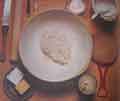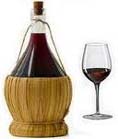How To Make Pastry
from Italian Traditional Food
Make pastry a success with these
rules
Check out these great Italian ideas at Amazon for Italian food and kitchen ideas.
So many puddings are made with pastry that it is important to be able to make
it well. Good pastry is not difficult if certain rules – which are often forgotten – are followed.

The main rules are:
1. Work in a cool, airy room. Plan to make the pastry before the kitchen becomes warm from other
cooking because a damp, warm atmosphere is disastrous.
2. Use fresh, fine-sifted plain flour (self-raising flour or baking powder produces
spongy-textured pastry), firm but not too hard fat (which would not blend properly with the flour) and ice-cold
water for mixing. Baking powder is sometimes used to lighten a rich pastry that has a lot of fat.
3. Handle flour and fat lightly but firmly. When rubbing fat into the flour, keep lifting it up
and crumbling the mixture between your fingers. This movement helps to aerate the pastry. Shake the bowl after 1-2
minutes to bring the larger lumps of fat to the surface and to show you how much more rubbing-in is necessary. This
is especially helpful when making rich shortcrust where over-rubbing makes
the pastry greasy.
Adding Water
4. Make sure that the correct amount of water is added. This may vary a little with the quality
of the flour. Too dry a mixture makes the pastry difficult to handle; it will crack when rolled out and crumble
after baking and will be dry to eat. Too wet a dough will shrink and lose shape while baking, and also make for
tough, hard pastry. The amount of water is usually indicated in a recipe and it is important that at least
two-thirds of the given quantity is added to the dry ingredients before mixing begins. This avoids over-working and
brings the ingredients quickly to a firm, smooth pastry, especially when making the foundation dough for puff
pastry.
Rolling Out Pastry
5. A marble slab or slate shelf is ideal for rolling out pastry because
it is smooth, solid and cool; otherwise, keep a board especially for this purpose (a laminated plastic surface is
fine). Once pastry is rolled out, always scrape slab or board thoroughly before rolling out new pastry to remove
any dough that may have stuck and which might cause further sticking. )This applies particularly to flaky or puff
pastry when rolling out is of paramount importance.) Use a minimum amount of flour for dusting when rolling,
otherwise too much will go into the pastry and spoil it. A heavy, plain wooden rolling pin without handles is best,
especially for puff pastry.
Chilling Pastry
6. Chill made pastry for about 30 minutes or leave it aside in a cool place for the same amount
of time. This gives the pastry a chance to relax and removes any elasticity which may cause shrinkage round edge of
dish.
7. It is essential when baking pastry to pre-set the oven to the required temperature. The
immediate heat sets the pastry in its correct shape and makes it possible to control the exact
amount of cooking time.
Read more Italian traditional food related articles here

Copyright © 2009 - . All Rights Reserved
Worldwide. Italian Traditional Food
You may not reprint articles from this website
without the written permission of the site owner.
Disclaimer: Articles on this
Website are provided for information purposes only. Italiantraditionalfood.com does not accept any responsibility
or liability for the use or misuse of the article content on this site or reliance by any person on the site's
contents.
| 



 Digg
Digg Stumbleupon
Stumbleupon Google Bookmarks
Google Bookmarks Delicious
Delicious Twitter
Twitter Facebook
Facebook Yahoo My Web
Yahoo My Web Reddit
Reddit